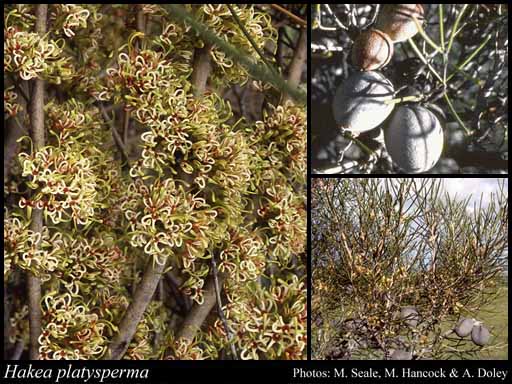- Reference
- Icon.Pl. 5:Tab.433 (1842)
- Conservation Code
- Not threatened
- Naturalised Status
- Native to Western Australia
- Name Status
- Current
Erect, non-lignotuberous shrub, 1-3 m high. Fl. cream/cream-pink-red, Jul to Oct. White/grey or yellow sand, sandy clay, often over laterite.

Scientific Description
Shrubs, 1-3 m high; branchlets hairy. Leaves alternate, 30-145(-155) mm long, 1-3 mm wide, glabrous; lamina terete, entire. Inflorescences axillary, cream; pedicels 5-8 mm long. Perianth 10-12 mm long, hairy; ovary glabrous; pistil 14-17.5 mm long, pollen presenter lateral, style glabrous. Follicles 45-75 mm long, 38-65 mm wide, corky tetrahedral projections (on external surfaces of fruit) absent; seed 33-46 mm long (including wing), 50-58 mm wide, the wing continuous. Flowers in July, August, September or October. Occurs in the Eremaean (ER) or South-west (SW) Botanical Province(s), in the Coolgardie (COO), Geraldton Sandplains (GS), Avon Wheatbelt (AW) or Mallee (MAL) IBRA subregion(s).
Distribution
- IBRA Regions
- Avon Wheatbelt, Coolgardie, Geraldton Sandplains, Mallee.
- IBRA Subregions
- Geraldton Hills, Katanning, Lesueur Sandplain, Merredin, Southern Cross, Western Mallee.
- Local Government Areas (LGAs)
- Carnamah, Coolgardie, Coorow, Corrigin, Dowerin, Dundas, Greater Geraldton, Kondinin, Moora, Narembeen, Northam, Northampton, Quairading, Tammin, Three Springs, Wongan-Ballidu, Wyalkatchem, Yilgarn.